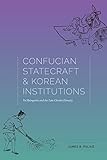Confucian statecraft and Korean Institutions : Yu Hyŏngwŏn and the late Chosŏn Dynasty / James B. Palais.
Material type: TextSeries: Publication details: Seattle : University of Washington Press, (c)2014.Description: 1 online resourceContent type:
TextSeries: Publication details: Seattle : University of Washington Press, (c)2014.Description: 1 online resourceContent type: - text
- computer
- online resource
- 9780295805115
- BL1842 .C664 2014
- COPYRIGHT NOT covered - Click this link to request copyright permission: https://lib.ciu.edu/copyright-request-form
| Item type | Current library | Collection | Call number | URL | Status | Date due | Barcode | |
|---|---|---|---|---|---|---|---|---|
 Online Book (LOGIN USING YOUR MY CIU LOGIN AND PASSWORD)
Online Book (LOGIN USING YOUR MY CIU LOGIN AND PASSWORD)
|
G. Allen Fleece Library ONLINE | Non-fiction | BL1842 (Browse shelf(Opens below)) | Link to resource | Available | ocn910935346 |
Includes bibliographies and index.
Confucian statecraft in the founding of Chosŏn -- The disintegration of the early Chosŏn system to 1592 -- Post-Imjin developments in military defense and the economy -- Remolding the ruling class through education and schools -- New schools: conservative restraints on radicalism -- Slavery: the slow path to abolition -- Land reform: compromises with the well-field model -- Redistributing wealth through land reform -- Late Chosŏn land reform proposals -- The royal division model: rotating duty soldiers and support taxpayers -- The debate over the military training agency, 1651-82 -- The search for alternative modes of military finance -- Military reorganization, weapons, and walls -- The military service system, 1682-1870 -- The king and his court -- Reforming the central beaurocracy -- Personnel policy -- Provincial and local administration -- The community compact system (Hyangyak) -- Yu Hyŏng-wŏn's community compact regulations -- Tribute and Taedong reform -- The Taedong model for official salaries and expenses -- Copper cash and the monetary system -- Yu Hyŏng-wŏn's analysis of currency -- A cycle of inflation and deflation -- Cash and economic change after 1731.
Seventeenth-century Korea was a country in crisis--successive invasions by Hideyoshi and the Manchus had rocked the Chosòn dynasty (1392-1910), which already was weakened by maladministration, internecine bureaucratic factionalism, unfair taxation, concentration of wealth, military problems, and other ills. Yu Hyòngwòn (1622-1673, pen name, Pan'gye), a recluse scholar, responded to this time of chaos and uncertainty by writing his modestly titled Pan'gye surok (The Jottings of Pan'gye), a virtual encyclopedia of Confucian statecraft, designed to support his plan for a revived and reformed Korean system of government. Although Yu was ignored in his own time by all but a few admirers and disciples, his ideas became prominent by the mid-eighteenth century as discussions were underway to solve problems in taxation, military service, and commercial activity. Yu has been viewed by Korean and Japanese scholars as a forerunner of modernization, but in Confucian Statecraft and Korean Institutions James B. Palais challenges this view, demonstrating that Yu was instead an outstanding example of the premodern tradition. Palais uses Yu Hyòngwòn's mammoth, pivotal text to examine the development and shape of the major institutions of Chosòn dynasty Korea. He has included a thorough treatment of the many Chinese classical and historical texts that Yu used as well as the available Korean primary sources and Korean and Japanese secondary scholarship. Palais traces the history of each of Yu's subjects from the beginning of the dynasty and pursues developments through the eighteenth and nineteenth centuries. He stresses both the classical and historical roots of Yu's reform ideas and analyzes the nature and degree of proto-capitalistic changes, such as the use of metallic currency, the introduction of wage labor into the agrarian economy, the development of unregulated commercial activity, and the appearance of industries with more differentiation of labor. Because it contains much comparative material, Confucian Statecraft and Korean Institutions will be of interest to scholars of China and Japan, as well as to Korea specialists. It also has much to say to scholars of agrarian society, slavery, landholding systems, bureaucracy, and developing economies.
COPYRIGHT NOT covered - Click this link to request copyright permission:
There are no comments on this title.
